See What You Can Be Part of...
Our Brief History
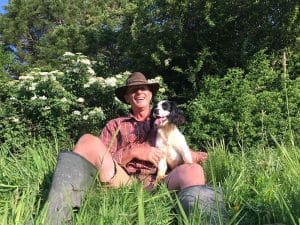 Gift a Tree was set up by Andy Fields in October 2021 after he experienced a near-death experience. Having been told he might live for just 6 months and having gone through surgery, chemotherapy, radiotherapy and being fed through a tube, Andy came out the other side with a completely new outlook on life.
Gift a Tree was set up by Andy Fields in October 2021 after he experienced a near-death experience. Having been told he might live for just 6 months and having gone through surgery, chemotherapy, radiotherapy and being fed through a tube, Andy came out the other side with a completely new outlook on life.
Andy said, “When someone goes through such trauma, you look at nature in an extremely positive way. For the first time I could truly hear the birds singing, the wind rustling the leaves in trees and insects buzzing around me. I could smell the grass and fully inhaled the true meaning of life. I can honestly say that I had never felt so alive. It is something we should all be aware of.”
Our founder had truly been awakened as to the importance of nature. However, he soon saw a less positive side.
Andy goes on to say, “I knew I had to do something! I looked around and saw green fields. Some people say, ‘the beautiful countryside’ but I saw these fields in a whole different way. They are green deserts dong little or even NOTHING for nature. Something had to be done“.
Andy decided to plant trees on his farm. He gave sheds to the local beekeeping club, dug a lake and introduced a boggy area for amphibians. In fact he turned the whole farm into a nature reserve where he still plants trees today. In just under two years the farm has been transformed and has attracted wildlife previously unheard of in Devon. It even had a wild stork roosting each night in 2022.
Since founding Gift a Tree Andy has partnered with charities worldwide, been a guest on several radio shows and is now involved in education programs worldwide to show the benefits of having trees to children worldwide. Gift a Tree is now responsible for planting tens of thousands of trees on a monthly basis
What is Re-Wilding?
Re-wilding is a conservation practice that involves returning land to its natural state, allowing ecosystems to thrive and species to flourish. In the UK, re-wilding has gained significant attention in recent years due to its many benefits. In this article, we will explore some of the key advantages of re-wilding in the UK.
Tree Planting and Re-Wilding at Bradford Farm
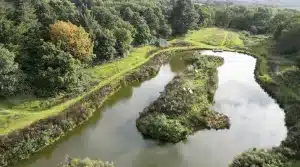 At Bradford Farm we are all about re-wilding. Recently, we have decided to plant trees not just on every patch of our land but through initiatives working with NGOs and charities worldwide. We are proud to be so committed and engaged to bringing nature back all over the world and reversing climate change. We now plant in 32 countries worldwide.
At Bradford Farm we are all about re-wilding. Recently, we have decided to plant trees not just on every patch of our land but through initiatives working with NGOs and charities worldwide. We are proud to be so committed and engaged to bringing nature back all over the world and reversing climate change. We now plant in 32 countries worldwide.
When we arrived on our farm in 2017, the fields were just boring grass – there was no significant wildlife to speak of. Since then we have introduced 23 bee hives, a natural lake, planted wild flower fields and are now dedicated to full time tree planting.
Letting Everything Natural Grow
Re-wilding is not just about trees. We are allowing the hedgerows to grow and only cutting back when absolutely necessary. This allows more berries to grow which attract more birds – it is sad that most farmers cut back their hedges just when the berries are ripening in late Summer and Autumn. Recent farming methods fundamentally starve birds that rely on such food sources. Since introducing our natural ecological method, we have seen an increase in all wildlife activity.
Weed are important too!
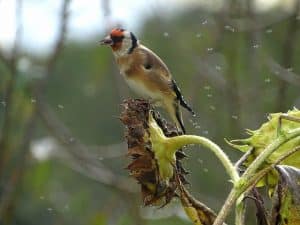 In addition to the hedgerows, we have let the weeds grow too. Weeds are important for a number of reasons.
In addition to the hedgerows, we have let the weeds grow too. Weeds are important for a number of reasons.
- Weeds provide cover for all varieties of nature such as frogs, pheasants, insects, spiders to name just a few
- Weeds provide a valuable food source for butterflies and encourages them to reproduce
- Weeds are a larder for smaller birds – caterpillars and grubs in the summer and seeds in the winter
Since letting our weeds grow we often see a ‘charm’ a group of 50 or more goldfinch – birds that are rapidly declining in the UK.
Encourage Amphibians, Waterfowl and Small Mammals
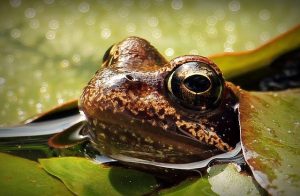
We are lucky to have a river running through the land. However, we thought we would do something for species that rely more on bogs and still water, so we dug a lake and a purpose built bog.
The temptation is to always put fish in straight away – but this was decided against so we could see what happens naturally over time.
Since excavating the lake just 18 months ago we have seen a massive increase in bird life, including ducks, geese, moorhens, herons, egrets, dippers and kingfishers to name a few. More importantly, because there are no fish in the water we have an abundance if insect larvae hatching encouraging 100s of swallows, swifts and house martins.
It has been amazing to see wild water flowers and reed-beds developing encouraging several different species of dragonfly which, in turn, encouraged hobbies visiting for the first time this year.
We also encouraged three boggy areas to excel naturally. Now we have 100s of frogs, toads, newts and millions of frog spawn. These also provide an invaluable food source for the ducks, herons and egrets. As the area is overgrown, it provides excellent hiding place for the frogs, tadpoles and newts.
Since leaving the grassy areas to overgrow, we have seen a massive increase in field mice. Too often all sorts of insects and small mammals are killed by industrial farm machinery which leaves little food for birds of prey.
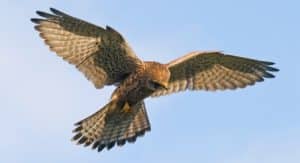
Grass is okay as long as it is NOT often cut. The reasons for this are as follows..
- Long grass provides excellent cover for field mice
- It is perfect habitat for grasshoppers
- Provides hiding places for deer
- Helps hedgehogs
- In the winter, it folds over providing a perfect blanket for the small mammals that depend on it
All of these benefits encourage birds of prey including owls and kestrels that rely on the rodents as a food source.
Did you know that kestrels alone have declined by two thirds in just one year in Devon alone. This is down to over-industrialised farming. Let’s get them back before it it too late.
Re-Wilding in the UK
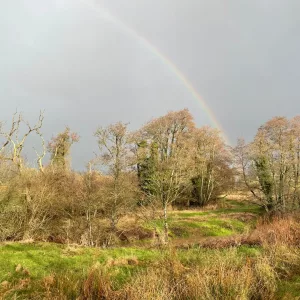 In recent years, advocates have been calling for the restoration of large areas of land to their natural state in the UK, as re-wilding is a process of restoring natural ecosystems and allowing them to function without human intervention. The benefits of re-wilding are numerous, including the restoration of biodiversity, the mitigation of climate change, and the promotion of a more sustainable and resilient landscape.
In recent years, advocates have been calling for the restoration of large areas of land to their natural state in the UK, as re-wilding is a process of restoring natural ecosystems and allowing them to function without human intervention. The benefits of re-wilding are numerous, including the restoration of biodiversity, the mitigation of climate change, and the promotion of a more sustainable and resilient landscape.
One of the primary arguments for re-wilding in the UK is the need to address the biodiversity crisis. The country is one of the most nature-depleted in the world, with many species facing extinction. Restoring ecosystems and reintroducing key species, such as wolves, lynx, and beavers, is believed by re-wilding advocates to help rebuild ecosystems and support the recovery of biodiversity. For instance, reintroducing beavers has been shown to improve water quality and create habitats for other wildlife.
Re-wilding also has the potential to mitigate the effects of climate change. By restoring natural ecosystems, carbon sequestration in the soil and vegetation can reduce carbon emissions and help combat climate change. Furthermore, re-wilding can promote sustainable land use practices, like agroforestry and regenerative agriculture, which can enhance soil health and increase carbon sequestration.
Despite the benefits of re-wilding, there are challenges to implementing the process in the UK. One of the main obstacles is the issue of land ownership, as much of the land in the country is privately owned, and many landowners may be resistant to re-wilding, which could potentially reduce the value of their land. Additionally, there may be concerns regarding public safety if certain species, such as wolves, are reintroduced.
To overcome these challenges, advocates of re-wilding in the UK are working to build partnerships with landowners and other stakeholders, like farmers and local communities. These partnerships can create a shared vision for re-wilding and ensure that the benefits of this process are widely understood and accepted. Additionally, policymakers can support re-wilding efforts by providing funding for restoration projects and creating incentives for landowners to participate in re-wilding.
In conclusion, re-wilding is a powerful tool for restoring ecosystems, supporting biodiversity, and promoting a more sustainable and resilient landscape in the UK. While there are challenges to implementing re-wilding, strong partnerships and policy support can overcome them. With continued investment and effort, the UK can become a global leader in re-wilding and create a brighter future for both people and wildlife.
Biodiversity
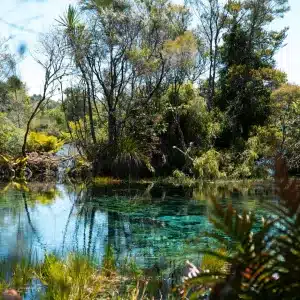 The UK has lost much of its native wildlife due to habitat destruction, climate change, and other factors. Re-wilding can help to restore these habitats and bring back lost species. By allowing nature to take its course and reducing human interference, re-wilding can create diverse and thriving ecosystems that support a wide range of species, including plants, insects, birds, and mammals.
The UK has lost much of its native wildlife due to habitat destruction, climate change, and other factors. Re-wilding can help to restore these habitats and bring back lost species. By allowing nature to take its course and reducing human interference, re-wilding can create diverse and thriving ecosystems that support a wide range of species, including plants, insects, birds, and mammals.
Biodiversity and ecosystems play a crucial role in supporting and sustaining wildlife. Biodiversity refers to the variety of living organisms found in an ecosystem, from plants and animals to microorganisms. Ecosystems, on the other hand, are the interactions between living and non-living components of an environment.
The benefits of biodiversity and ecosystems to wildlife are manifold. They provide food, shelter, and breeding habitats for a diverse array of species. Additionally, ecosystems regulate natural processes such as nutrient cycling, pollination, and water purification, all of which are essential for the survival of wildlife.
Biodiversity and ecosystems also promote resilience in wildlife populations. As an ecosystem becomes more diverse, it can adapt better to changes in its environment, making it less vulnerable to disturbances like climate change, disease outbreaks, or habitat destruction.
Moreover, biodiversity and ecosystems can provide significant economic benefits to human societies, from recreation and tourism to the production of food, medicines, and other goods. Protecting and preserving biodiversity and ecosystems can contribute to sustainable economic development while also ensuring the continued survival and flourishing of wildlife.
In conclusion, biodiversity and ecosystems are vital for the survival and well-being of wildlife. They provide essential resources and habitats for a diverse array of species, promote resilience, and offer significant economic benefits to human societies. Protecting and restoring biodiversity and ecosystems is crucial for ensuring the continued survival and flourishing of wildlife, as well as promoting sustainable development for human societies.
Carbon Sequestration
Re-wilding can also help to mitigate the effects of climate change by capturing and storing carbon. Natural habitats, such as forests, wetlands, and grasslands, are excellent at storing carbon, which helps to mitigate the effects of greenhouse gas emissions. By re-wilding areas that have been degraded or deforested, we can help to sequester carbon and reduce our carbon footprint. Trees and other vegetation absorb carbon dioxide from the atmosphere, which helps to reduce the amount of greenhouse gases in the air.
Flood Control & Prevention
Re-wilding can also help to prevent flooding in the UK. Natural habitats, such as wetlands and floodplains, can absorb large amounts of water, reducing the risk of flooding downstream. By restoring these habitats, we can create natural flood barriers and reduce the damage caused by floods. Wild landscapes can help to reduce the risk of flooding by slowing the flow of water and allowing it to be absorbed into the soil. This can help to reduce the damage caused by flash floods, which can be particularly severe in urban areas
Recreational Opportunities & Ecotourism
Re-wilding can also bring economic benefits to local communities through providing new opportunities for recreation and ecotourism. As more natural habitats are restored, there are opportunities for people to visit these areas and see the diverse wildlife that inhabits them. This can create jobs and bring in revenue for local businesses. This can bring economic benefits to local communities and help to raise awareness of the importance of preserving wild spaces. For example, the Peak District in England is a popular destination for hiking and outdoor activities, and the introduction of wild landscapes there would likely attract even more visitors.
Mental and Physical Health Benefits
Spending time in nature has been shown to have numerous benefits for mental and physical health. Re-wilding can provide new opportunities for people to connect with nature, which can help to reduce stress, improve mood, and promote physical activity.
Conclusion
In conclusion, re-wilding offers a number of benefits for the UK, including increased biodiversity, carbon sequestration, flood control, recreational opportunities, and improved health outcomes. By preserving and restoring wild landscapes, we can ensure that future generations can enjoy the benefits of re-wilding.
Introducing Andy
Please Help as it All Costs Money
Through gifting a tree to a friend you allow us to plant another tree on our property and expand the process. In return, we will send you a certificate with the trees exact location so you can view its growth in years to come.
We are lucky to have a river running through the land. However, we thought we would do something for species that rely more on bogs and still water, so we dug a lake and a purpose built bog.
The temptation is to always put fish in straight away – but this was decided against so we could see what happens naturally over time.
Since excavating the lake just 18 months ago we have seen a massive increase in bird life, including ducks, geese, moorhens, herons, egrets, dippers and kingfishers to name a few. More importantly, because there are no fish in the water we have an abundance if insect larvae hatching encouraging 100s of swallows, swifts and house martins.
It has been amazing to see wild water flowers and reed-beds developing encouraging several different species of dragonfly which, in turn, encouraged hobbies visiting for the first time this year.
We also encouraged three boggy areas to excel naturally. Now we have 100s of frogs, toads, newts and millions of frog spawn. These also provide an invaluable food source for the ducks, herons and egrets. As the area is overgrown, it provides excellent hiding place for the frogs, tadpoles and newts.
